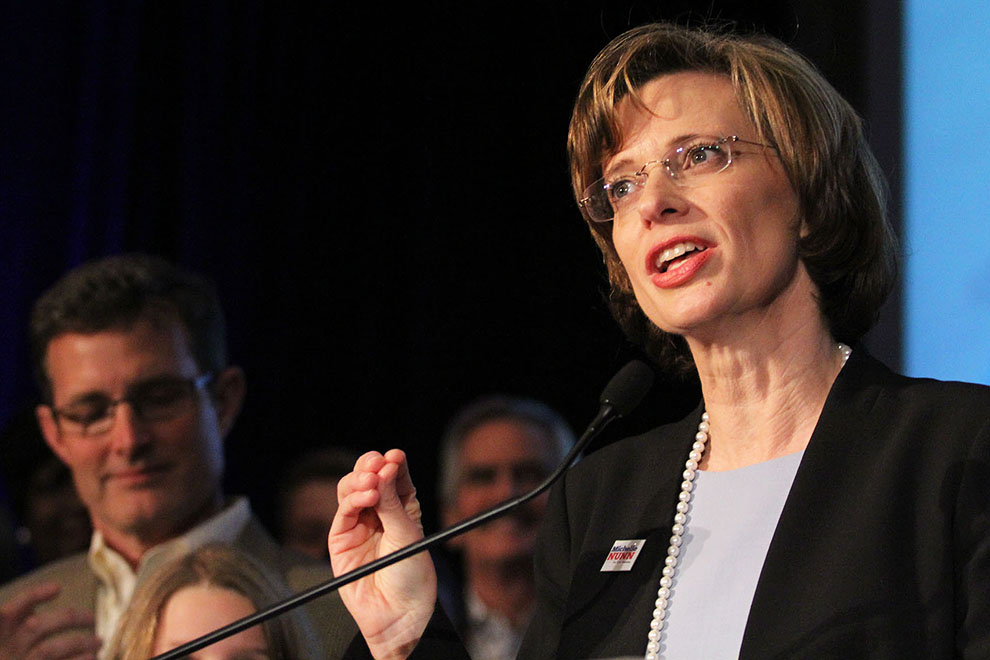Twelve weeks of campaigning have yet to run before the US midterm election ballots will be counted, but most pundits and pollsters – using both traditional polling and probability assessments – are predicting that Republicans will retake the Senate majority they lost in 2006 and keep control of the House of Representatives. Recent polling from the political scientists at the Washington Post’s bullish Monkey Cage blog indicates that Republicans have an 86 per cent chance of taking control of the Senate and are almost 100 per cent likely to keep control of the House of Representatives.
Indeed, the impression left by some commentary is that the contest is over even before the primaries are finished. It isn’t just the polls driving this narrative, it’s also two undeniable facts that weigh against Democrats and in favour of Republicans: Barack Obama, in the sixth year of his term, is rating well below 50 per cent, and the power of Democrat voters has been corralled by electoral boundaries drawn by Republican-controlled state houses.
Because senators are re-elected every six years, thirty-three of the one hundred Senate seats are up for grabs in November. A further three special elections in Hawaii, Oklahoma and South Carolina will fill vacancies that occurred during the 113th Congress. Of this total of thirty-six seats, fifteen are currently held by Republicans and twenty-one by Democrats. With fifty-three senators and two independents caucusing with them, the Democrats currently hold the Senate majority, so the Republicans must gain six seats and lose none to take control. Of the Senate seats in play, most political observers consider six to be safe Democratic seats and eleven to be safe for the Republicans. As many as a dozen Senate races are expected to be fairly close and these results will decide who has the majority.
Most of the “toss-up” Senate races are seats currently held by Democrats. Three of these (Montana, South Dakota and West Virginia) seem highly likely to switch into Republican control. With the appointed incumbent senator John Walsh withdrawing amid plagiarism allegations, the Democrats currently don’t even have a candidate in the Montana special election to replace Max Baucus, who was appointed US Ambassador to China.
At least eight other Democrat-held seats are also at risk – North Carolina, Iowa, Michigan, Louisiana, Colorado, Alaska, New Hampshire and Arkansas – and some might add Minnesota to this list. Democrats believe they have a chance of winning two Republican-held seats, Georgia and Kentucky.
While it’s relatively easy to see how the Republicans get to forty-eight seats, they will need at least three more to gain a working majority. Failing this, it’s possible to imagine a scenario where vice-president Joe Biden, the person who could break a tie in a 50–50 Senate, becomes the key to everything. If the Democrats were to play the same games as Republicans in opposition and use the filibuster indiscriminately, then control of the Senate would require sixty seats.
The additional victories Republicans need must come either by defeating Democratic incumbents in red states (Alaska, Arkansas, Louisiana, North Carolina) or by picking off the seats in blue or purple states dominated by the Democrats in presidential elections. Four states that Obama won in 2008 and 2012 (Colorado, Iowa, Michigan, New Hampshire) are either highly competitive or could become competitive. The ability of Democrats to protect all of these states could be their key to a Senate victory.
Two other races will be critical for both parties. In Georgia, huge sums are being spent on advertising in the race between Republican businessman David Perdue and Democrat Michelle Nunn, daughter of former senator Sam Nunn. Georgia hasn’t elected a Democrat senator since 2000, but the Republican spending is a good indication that this race is seen as close.
The biggest scalp the Democrats might claim in November is that of Senate GOP leader Mitch McConnell in Kentucky. A poll average by Real Clear Politics has McConnell ahead of his Democrat rival Alison Lundergan Grimes by 2.5 per cent. McConnell faced a vicious primary where he was challenged by the Tea Party, and in the bitter aftermath the conservatives have yet to put their support behind him.
Despite a raft of primary challenges, interestingly, the Tea Party has failed to overturn a single incumbent Republican senator for the first time since 2008. Tea Party–backed candidates had been hopeful of emulating Dave Brat, who stunned the establishment with his primary win over House GOP leader Eric Cantor. Undone by flawed candidates, the insurgents now claim they have co-opted the Republican Party by forcing incumbents to adopt their ultra-conservative positions on issues such as immigration and government spending. These “cannibal” conservative groups have spent over $20 million against Republicans – money that could have been used to target Democrats.
An examination of the Senate races on websites such as Larry Sabato’s Crystal Ball, the Cook Political Report and FiveThirtyEight shows that each contest is already revolving around a set of political dynamics, policies and personalities unique to each state. With three months of campaigning still remaining, it is too soon to make firm predictions. But the Democrats clearly have some tough campaigns ahead if they are to hold the Senate. The alternative scenario would be a disaster for a president and a White House already struggling to drive any sort of agenda in the Congress. They would be left completely isolated.
November will also see elections for all 435 seats of the House of Representatives, where Republicans already have a strong majority. Democrats need to pick up seventeen seats to switch the balance of power but few analysts expect that to happen. Because of the very real advantages of incumbency and partisan redistricting following the 2010 census, only about sixty House districts are considered competitive and only perhaps a dozen are close. The gerrymandering is a prime reason why Democrats fell seventeen seats short of winning a House majority in 2012 although their congressional candidates drew about 1.4 million more votes than Republicans nationwide. Under these conditions, estimates Alan Abramowitz, a professor at Emory University, Democrats would need a lead of twelve to fourteen points on the “generic ballot” to regain control; they currently lead by 2.5 points.
Republicans are predicted to pick up roughly five to eight House seats. This is despite some amazingly low Republican favourability ratings. A recent ABC/Washington Post poll found that the Democratic Party is viewed favourably by 49 per cent of voters, with the Republican Party at 35 per cent – a historically high differential. At the same time, a majority of people (51 per cent) disapproved of their own federal representative, the highest in twenty-five years of polling. A Gallup poll finds congressional job approval figures are down at 16 per cent, the lowest since Gallup first measured this in 1974, and five points lower than in 2010.
It’s not clear how these opinions affect the way people vote. The impact of the historically low levels of public approval for national law-makers is thus a key unknown for the midterm elections, meaning there is no certainty that today’s findings will translate into votes at the polling booth. In years when congressional job approval is low, there tends to be greater turnover in House membership.
But other factors are also in play. Americans are not just disgusted with Congress, they are also unhappy with the direction of the country more generally. Despite improvements in employment, consumer confidence and the economy generally, only one-in-four (23 per cent) respondents are satisfied with the state of the nation, similar to the share in 2010 (22 per cent). Again, high levels of dissatisfaction with the direction of the country are usually linked to higher turnover in congressional seats.
Although the president is not a candidate in midterm election years, his standing with voters is usually a significant predictor of election outcomes. When the president is unpopular, his party typically loses a substantial number of seats in the House of Representatives. President Obama’s job approval rating has plummeted to an all-time low of 40 per cent in the most recent NBC/Wall Street Journal poll. It was 44 per cent at the time of the 2010 elections, when Democrats lost more than sixty seats in the House. While history shows no proportionality between the president’s job approval rating and seats lost, it does show that the party enters dangerous territory when his rating falls below 50 per cent.
Disgust with the political system and low political enthusiasm may mean low voter turnout. Midterm turnouts – already generally low – usually favour Republicans, with poor turnouts among minorities and the young who are more likely to support Democrats, and larger turnouts among older, white Americans who are more likely to support Republicans. This year the Democrats are doing their best to reverse this pattern, pouring more money into identifying, registering and turning out their voters than in any previous midterm election.
More intangibles and unknowns lie ahead. Larry Sabato has cautioned that 2014 is not 2006 or 2010 and that this year the old adages may not hold true. This is exemplified by the fact that for the first time since the 1998 midterms, polling finds no single issue registers with more than 20 per cent of voters. Domestic issues usually drive elections and this year economic issues and concerns about income disparities still rank, although employment and consumer confidence are both up. The growing acceptance of Obamacare and the failures of Congress on issues such as immigration may play against the Republicans. Recent crises in Russia, the Middle East, Libya and Iraq may conspire to boost or depress Obama’s ratings and the public’s mood in unpredictable ways.
This lack of focus means the campaigners are struggling to find pressure points to motivate constituents to get out to vote at a time when political energy is low. The political lethargy among progressives, starting with Obama himself, is born of the realisation that nothing can be done to advance their agenda through a gridlocked Congress and the intransigence of Republican opposition. Republicans, on the other hand, have been cowed by the Tea Party into adopting positions that don’t reflect voters’ concerns and traditional GOP values. As a consequence, midterm election campaigning has effectively been ceded to outside groups and individuals with huge sums of money and no accountability. This year these groups will rival the candidates in the money they spend and in doing so, they will significantly influence the election outcomes. •




